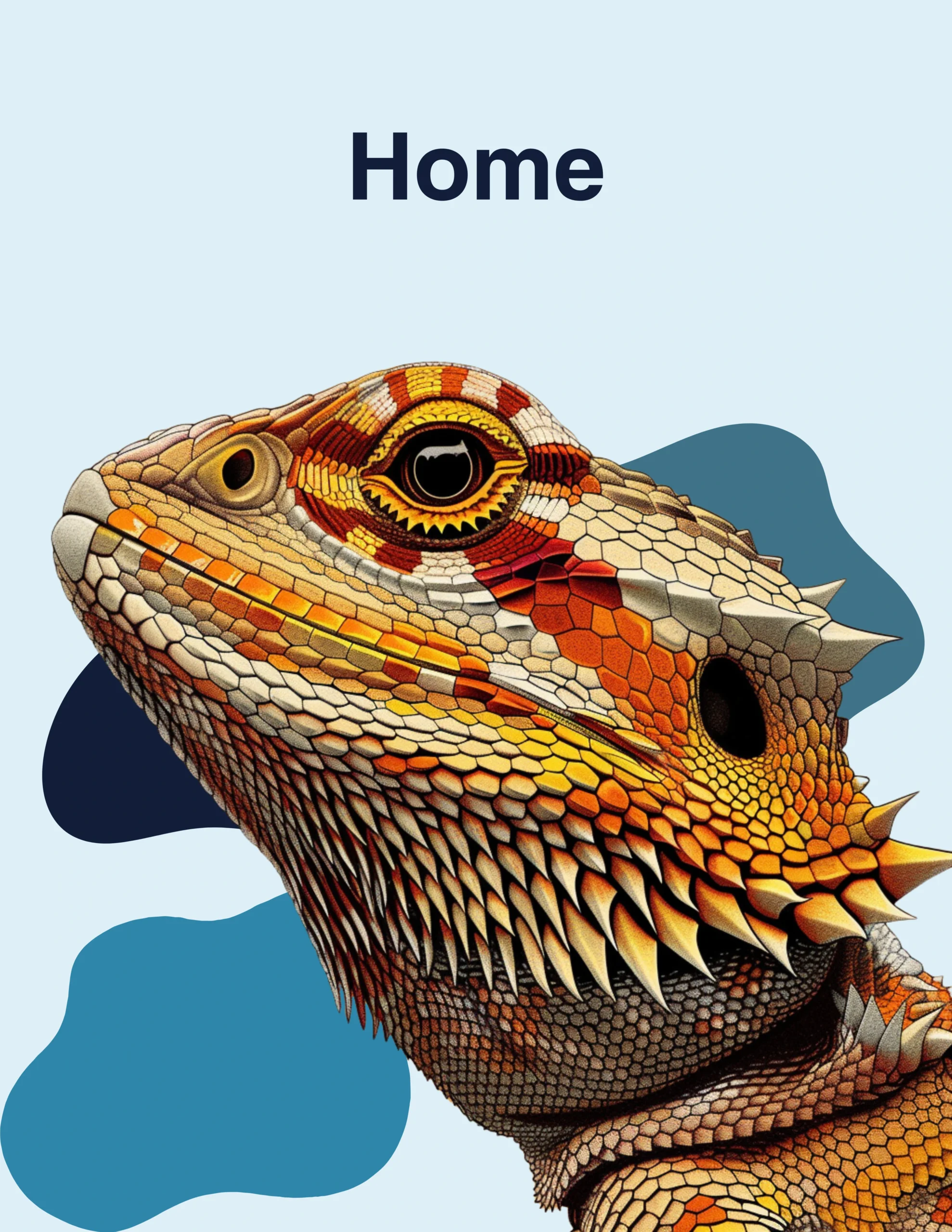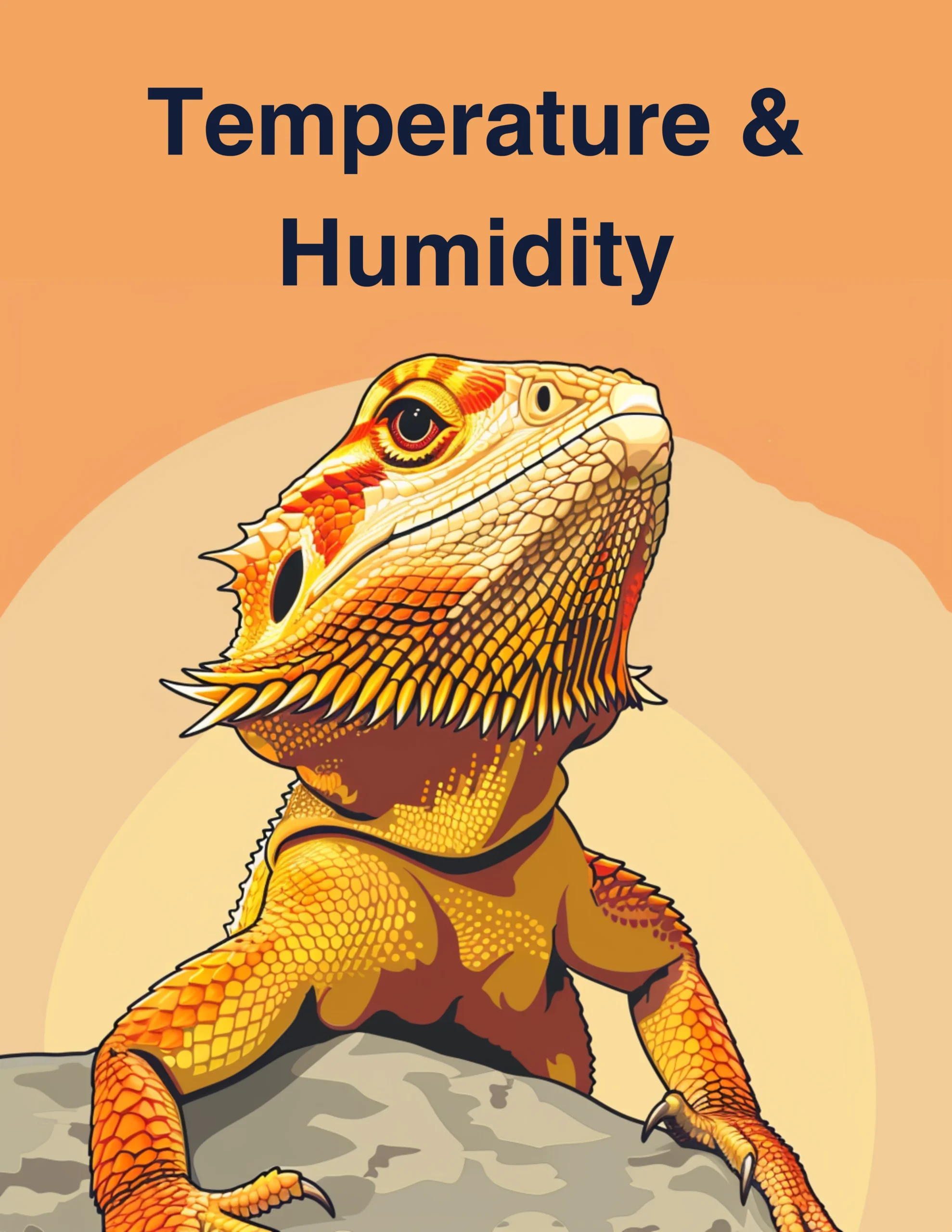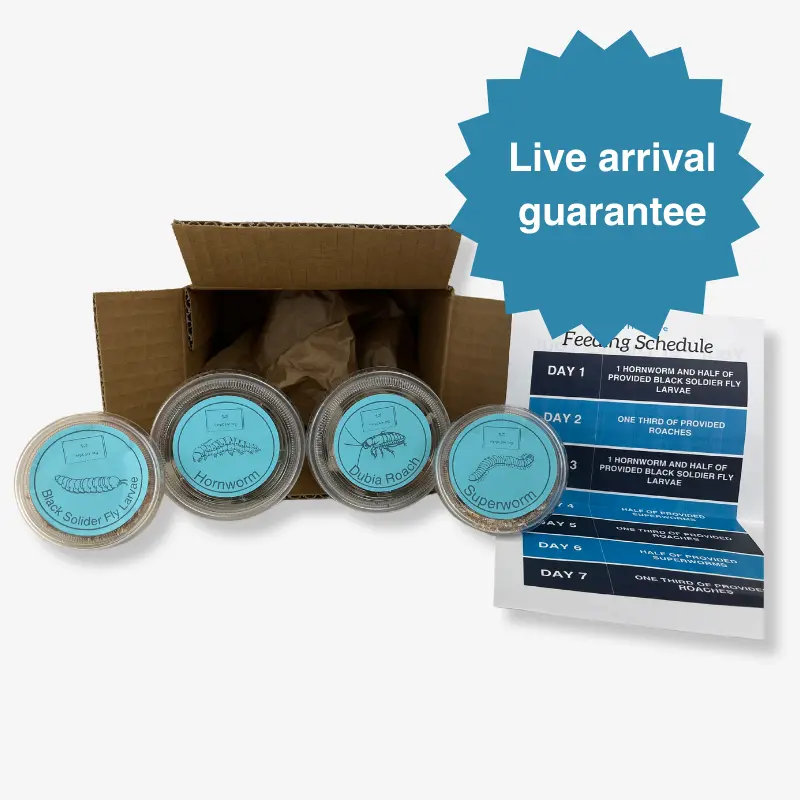
Diet and Nutrition
Bearded Dragon Care Guide
Diet and Nutrition Overview
Required Foods:
Insects
Greens/ Vegetables
Required Budget:
$25-100 Monthly
Priority Level:
High
The importance of diet and nutrition
TLDR:
Ensuring your bearded dragon’s health requires a proper diet and nutrition. In the past, dietary needs have been dangerously oversimplified. Without the right nutrients, bearded dragons are prone to serious health complications.
A properly fed pet will:
- Exhibit more natural behaviors, enriching your experience as a pet owner
- Live a longer, healthier, and more fulfilling life
- Avoid expensive, heartbreaking disorders and diseases caused by malnutrition
Feeding your bearded dragon correctly is challenging for both new and experienced owners. Beyond their complex dietary needs, opinions on proper nutrition vary widely. At ReptiBites, we take diet and nutrition seriously, relying on science and research to ensure your pet thrives.

We’re not self proclaimed experts. Everything here is cited and attributed to well-educated and experienced researchers, vets, and non-profits. Don’t trust any site that does it differently. They’re almost always packed full of bad info. Want to see our source? Just click the check.
Core Nutritional Principles
Diet Diversity is a requirement
A diet that is not made up of various food items is not meeting their nutritional needs. To stay healthy, they require a wide range of food items.
Overfeeding and Underfeeding are dangerous
Obesity in captive reptiles is a serious health risk. Many bearded dragons don’t have an ‘off’ switch when it comes to how much they’ll eat. As their owner, it’s your responsibility to control their portions.
Bearded dragons need both animal matter and plant matter for a complete diet
As omnivores, bearded dragons rely on both plant and animal matter for essential nutrients.
How food is sourced is important
Different feeder insects have different nutritional contents. The source of your feeder insects also impacts their nutritional vaue as it is deeply dependent on how they were raised, and what they are gutloaded with.
Core Nutritional Principles Explained
To understand the dietary needs of captive bearded dragons, the best place to start is by studying their wild behavior. Thankfully, we have access to a fair amount of research in this domain.
The first thing that becomes abundantly clear is that wild bearded dragons eat an extraordinarily diverse diet. They are opportunistic hunters that consume a wide variety of prey—from termites, to flying insects (like bees and wasps), to vertebrate prey. They also consume plant matter from various families.
This diversity indicates that a captive bearded dragon requires a wide variety of food items, including both animal matter (insects) and plant matter (leafy greens and flowers).
World-class veterinarian and researcher Mark A. Mitchell summarized it best in his article “Diversity is the key to success with reptile diets”: “By expanding the dietary offerings provided to captive reptiles, we can ensure they are exposed to a broader range of nutrients, as well as limit the likelihood of the pets developing a nutritional disease.”
Research into feeder insects further confirms that different types of insects have vastly different nutrient profiles. Feeding only one or two types of insects will almost certainly omit key nutrients that a more diverse diet would provide.
Vets and researchers also emphasize the risk of obesity in captive reptiles. Obesity is linked to various other health issues. Given that captive bearded dragons require far less energy than their wild counterparts, it is critical to limit food intake to maintain a healthy body condition.
Buying food items from reputable sources is crucial. Research into the nutritional value of feeder insects shows that the rearing techniques dramatically affect their nutrient content. Many feeder insects on the market are raised as cheaply as possible, often resulting in sub-optimal nutrient profiles.
To summarize, the available literature is very clear:
- A diverse diet is required; without a wide variety of food items, your pet will miss key nutrients.
- Overfeeding causes obesity, leading to avoidable health issues.
- Bearded dragons need both animal matter (insects) and plant matter (various greens).
- Source feeder insects from reputable companies that prioritize proper rearing techniques.
The Importance of Diet Diversity
TLDR:
Diet diversity is essential for a healthy bearded dragon. Different feeder insects offer distinct nutrient profiles ; feeding only one or two types will inevitably leave nutritional gaps.
The chart below compares black soldier fly larvae and superworms, highlighting differences in calcium and vitamin content.
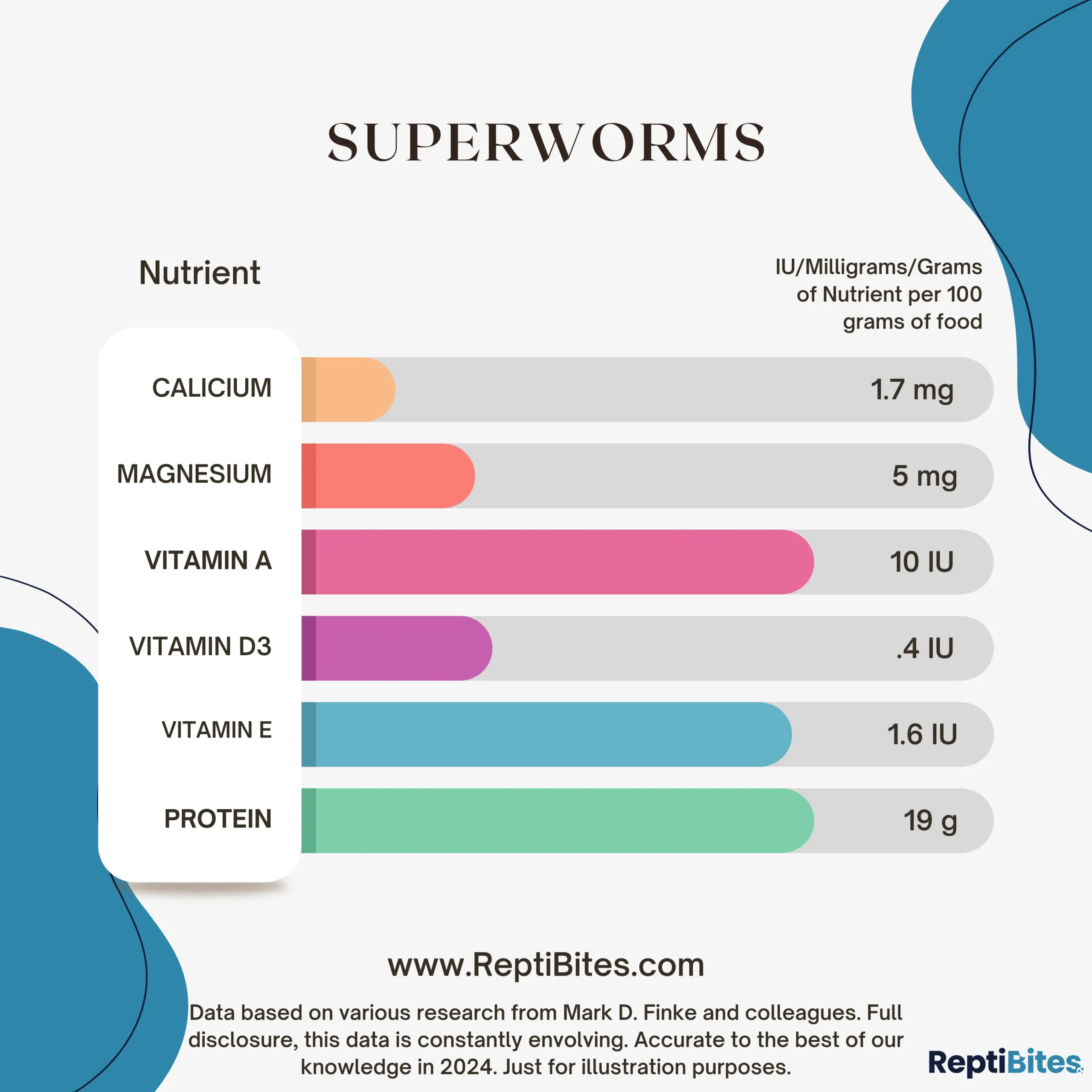
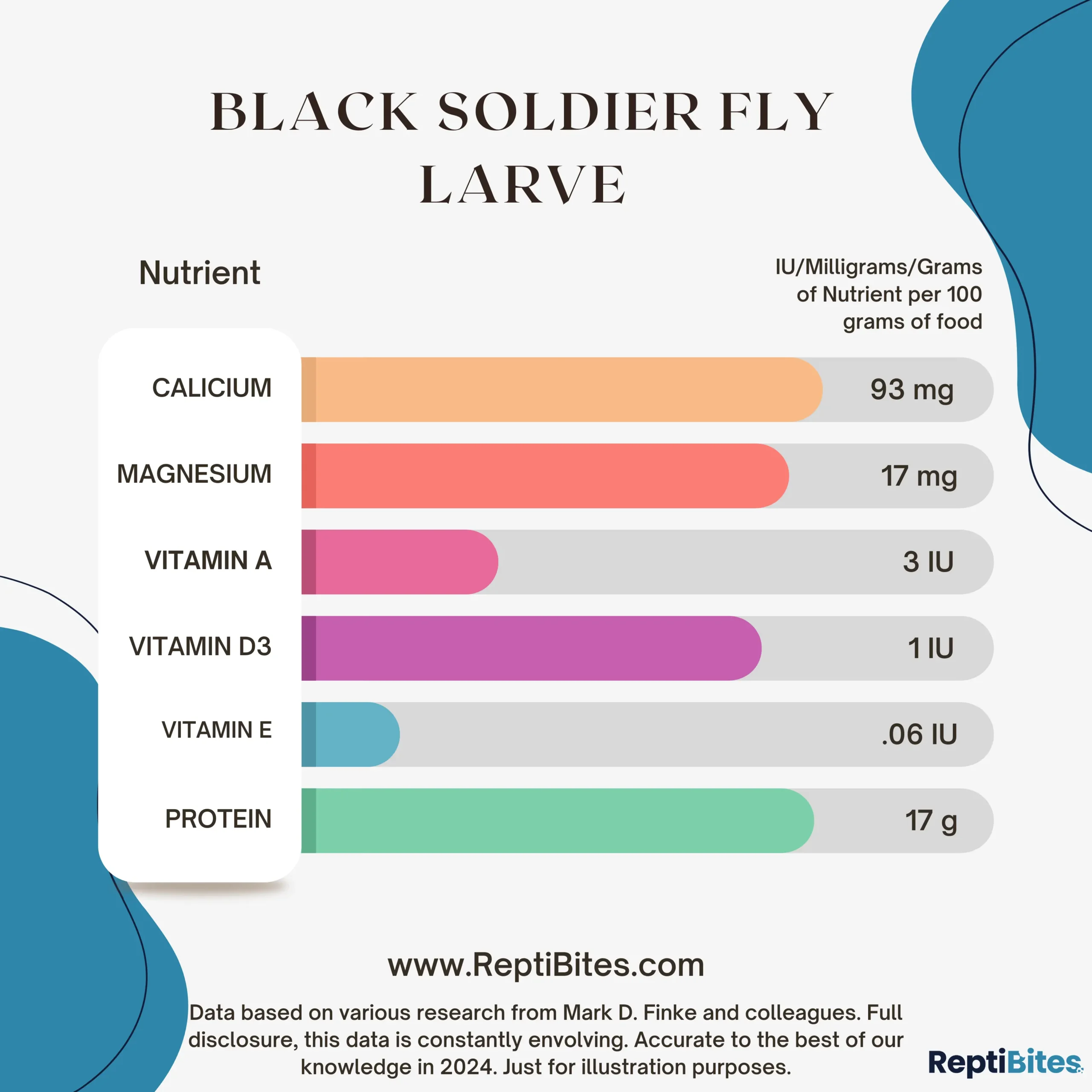
This result is amplified further when you compare a single insect diet to a multi-insect diet. Below is a comparison of ReptiBites diet packages versus a cricket-only diet. It’s not even close!
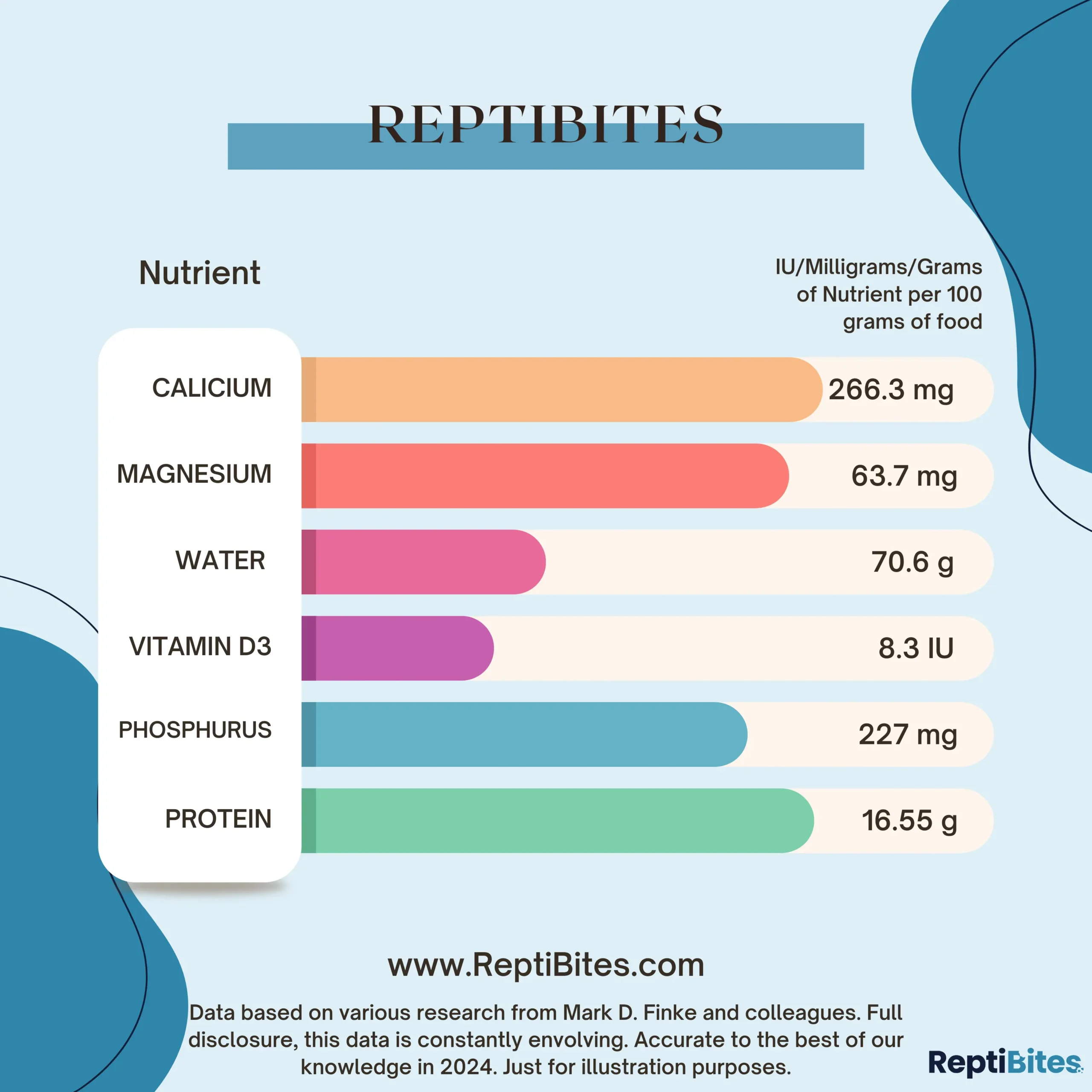
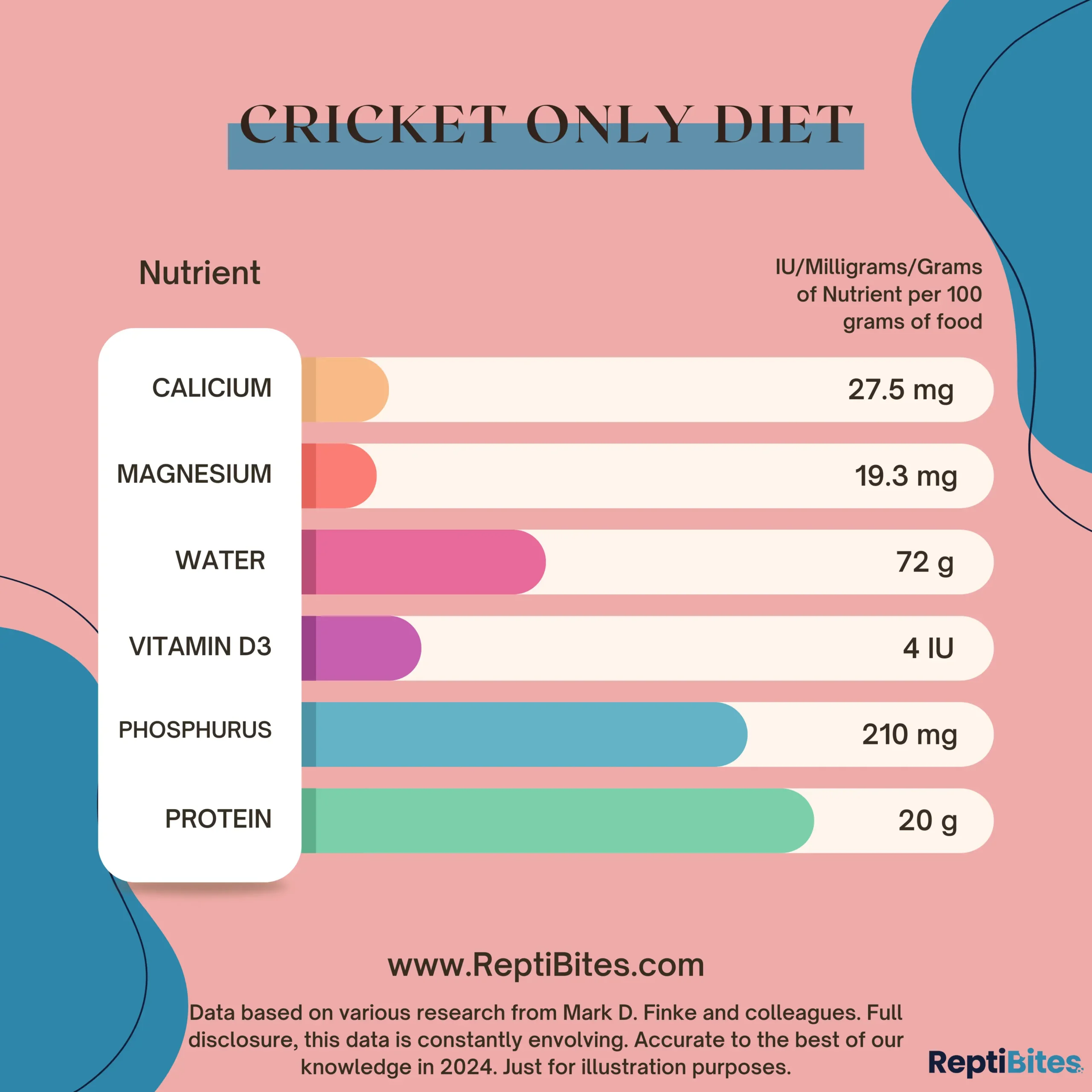
Feeding a variety of insects helps ensure your pet’s nutritional needs are fully met. A diverse diet also offers additional benefits:
- It mimics their wild feeding habits, creating a more natural and enriching environment.
- It promotes a proper appetite and prevents your pet from becoming overly fixated on a single food source.
- It ensures balanced hydration by including high water content options alongside nutrient-dense foods.
The team at My Nature Lab, which cares for over 100 reptiles, follows a diverse diet as a fundamental care principle. Their animals are extremely healthy—many surpassing the typical captive lifespan—and they have not observed any diet-related health concerns.
Diet diversity is equally important for plant matter; keep plant options fresh and varied.
If you care about your pet, you need to provide a diverse diet.
The evolution of proper diet as bearded dragons age
A fascinating aspect of bearded dragons is how their diet shifts with age. Younger dragons favor protein-rich foods such as insects and small vertebrates, while adults shift toward a higher proportion of plant matter. Proper feeding requires adapting to these changes.
The ideal insect-to-green ratio for bearded dragons is debated among experts. Here’s our full explanation of the recommended ratios.
Hatchlings 0-3 Months:
80% animal matter
20% plant matter
Young Juveniles 3-6 months:
70% animal matter
30% plant matter
Older Juveniles 6-12 Months:
65% animal matter
35% plant matter
Sub-Adults and Adults 12+ months old:
30-40% animal matter
60-70% plant matter
How we determined our recommended green to insect ratios
Babies and Juveniles
Younger dragons’ diets are more straightforward. Research here seems to be fairly consistent. Juvenile and baby dragons consume 20-50% plant matter by dry weight. When converted to as-fed values, this equals 70% animal matter/30% plant matter or 36% animal matter/64% plant matter.
Traditional husbandry suggests very young dragons eat less plant matter, increasing as they mature in juveniles and young adults. As a result, we suggest a gradual change as they mature.
Adults
Here is where the controversy begins: research shows wide variation in the plant and animal matter consumed by adult bearded dragons.
One recent study found that adults consumed 70% animal matter to 30% plant matter during a short period. Critics argue that seasonal variations may affect these ratios, but the findings still offer valuable insight.
Historic research has shown that adults consumed as much as 97% plant matter at one time and 78% at another , while another source reports an 80% plant to 20% animal matter ratio .
Conversely, research on a closely related species—based on six years of data and over 220 samples—suggests an 80% animal and 20% plant diet .
Despite these conflicting data, it is clear that bearded dragon diets vary with seasonal food availability. They tend to be more insect-based during the warmer, wetter months and shift toward a more plant-based diet in cooler seasons.
Based on these findings, we recommend that adult bearded dragons consume 30–50% animal matter and 50–70% plant matter by volume. As a general rule, offer more greens than insects at each meal.
Note on the importance of this information:
The total amount of food consumed is as important as the greens-to-insects ratio. Tracking the exact ratio and determining the optimal balance is challenging. As a result we would place more importance on the total caloric intake of your bearded dragon.
How much should my dragon eat?
There are many techniques for determining how much your dragon should eat. You’ve likely heard recommendations such as feeding as much as your dragon will eat in a set time or offering a specific number of insects per day based on its age.
These recommendations range from completely false, to not all that helpful. Modern tools offer better accuracy. Research on Field Metabolic Rate (FMR) allows us to accurately estimate your dragon’s food needs based on its age, size, and weight. These methods are increasingly common among top reptile vets.
The tool below uses the latest research to estimate daily food needs based on your dragon’s body weight and age.
Bearded Dragon Feeding Calculator
Results
Below is an estimate of the number of insects needed to meet your dragon’s insect calorie requirement per feeding—if you were to rely on just one type of feeder. This is only an illustration; you don’t need to feed all of these, just choose the feeder(s) that work best for your dragon.
| Insect Type | Estimated Quantity per Feeding | Total Insect Weight (g) |
|---|
Disclaimer: This tool provides a rough estimate as a reference point. It is designed for an animal housed in a properly sized enclosure with plenty of room to exercise and explore. Animals housed in smaller enclosures will likely need even less food.
We are fully confident in its theoretical accuracy, however, every animal is different. For tailored advice, consult a reputable vet. If you’re a current customer and the tool suggests a different amount than your feeding schedule, don’t worry! Our feeding schedules are based on the same research and tailored to the insect sizes we provide. Use the QR code on your schedule for helping making adjustments specific to your pet.
How does this tool work and why can I trust it?
Fair warning, this is going to get technical.
Our tool is based on Field Metabolic Rate (FMR), a measure of the energy animals need in their natural habitats. In simple terms, it measures the energy needed for daily survival activities like hunting, growing, and digesting food. Thus, how much food they need to eat to meet this energy requirement.
Bearded dragons haven’t been directly studied for energy needs, but we are VERY confident in the use of this research for bearded dragons. This is for a couple reasons:
- There are strong trends among energetic requirements among species of the same families. Ie, reptiles show much less variation in energetic needs when compared to each other (when mass is accounted for), then when compared to other animal families like mammals.
- Habitat environment appears to be a strong indicator in the difference of energetic needs in inter-family analysis. For example, desert reptiles are consistent in their energetic needs when accounted for weight.
- Close relatives of the bearded dragon HAVE been studied in regard to their energetic needs. Based on the above two points, this data should predict the energetic needs of bearded dragons with a very high degree of accuracy.
The Math
Here’s how the math behind our tool works:
Our starting point is a prediction equation from a summary of FMR data: kJ/day = a(g body mass)^b
‘a’ and ‘b’ are constants calculated to provide accurate estimates. We use constants specific to desert lizards, the best match for bearded dragons.
kJ/day = 0.177 (body mass in grams)^0.935
A couple more steps. This equation estimates the FMR of a wild animal. One of the most prolific authors in the field of metabolic rate research estimates captive animals would need 60-70% of the energy their wild counterparts need if they are very active and as low as 20% if they are not active at all and are not maintaining a proper internal temperature. We discount the equation by 65% to match proper captive conditions.
kJ/day = [(.177*(weight in grams)^.935)*(.65)]
As it stands, this equation calculates the energy needed in Kilojoules (kJ). Calories is a more standard unit for nutrition related calculations in the United States, so let’s switch out the unit to calories by dividing the whole equation by 4.184.
The Final Equation:
Calorie Needs per day = [(.177*(weight in grams)^.935)*(.65)]/4.184
Bearded dragons are somewhat unique as a reptile in that their diet is composed of both animal matter and plant matter. Importantly, the required ratio of each shifts as they age. To ensure the calculator accounts for this, we need to add some additional logic.
To assess the required amounts of both greens and insects, we first need to establish how calorically dense they are. While both insects and greens can vary in caloric content, we used average caloric values for common feeder insects and greens:
- Insects: ~1.7–2.4 calories per gram (depending on species/size)
- Leafy Greens: 7 calories per 30 grams (about one cup), or ~0.23 calories per gram
We know that the ratio of insects to greens shifts as dragons age. These ratios are commonly provided in as-fed ratios. The calculator takes this into account (using our recommendations), and provides the recommendation that matches this as-fed ratio.
By combining well-researched age-dependent ratios with realistic calorie estimates, we provide a structured yet flexible guide to feeding. This ensures younger dragons receive sufficient protein for growth while older dragons maintain healthy body composition with more plant matter. All values and calculations are based on recognized feeding guidelines and average nutritional data, so you can trust these recommendations as a reliable starting point.
Now let’s check our math. We’ll estimate an adult bearded dragon weighs about 400 grams; our estimation shows they need about 11.5 calories per day.
We can easily transfer this caloric value into insect weights using research on the nutritional content of feeder insects. A word of caution here, every insect supplier seems to have different definitions of insect sizes. A medium dubia roach from us probably isn’t the same as it is from another supplier. So we’ll use weight and an estimation of quantity:
- 2.7 grams of dubia roaches, or about 3-4 large dubias
- 7.28 grams of hornworms, or about 2-3 large hornworms
- 1.91 grams of superworms, or about 4-5 large superworms
- 2.41 grams of BSFL, or about 25-35 medium-large sized BSFL
And a small salad of about a cup. To be clear, this is if you were only to feed one insect type. It is not the sum of all the bugs in the list. Of course, we don’t want to provide insects and greens every day, and want to ensure we follow the recommended schedule we have outlined. This example is purely for illustration. This matches closely with rough estimations provided by veterinarians.
Now that you know how it works, go use the calculator for your pet’s specific weight!
One final note: Tools like this are always, of course, just a recommendation. Keep a close eye on your pet and adjust their feeding quantities according to their weight. All we aim to do with our calculator is give you access to the latest science regarding proper energy and feeding practices.
What if my dragon is under or overweight?
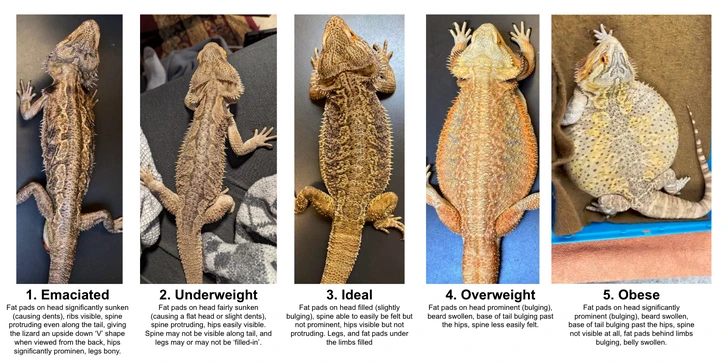
If your dragon isn’t at an ideal weight (especially as a sub-adult or adult), this recommendation isn’t as accurate. Our general recommendation would be to cut an entire feeding session out of the week for obese and overweight dragons, and add 1-2 feedings for underweight dragons. This topic is best discussed with a vet that can provide more accurate insights.
Does this work for growing animals?
It does! Interestingly, research so far suggests that neonate (baby and growing animals) reptiles do not have a variance in their FMR when mass is accounted for. Put simply, smaller animals seem to need a proportionate energy to larger animals.
The myth that young animals need lots of food to grow is likely based on captive reptiles being overfed and growing far more rapidly than their wild counterparts. It does seem to be true that overfeeding at a younger age is probably less destructive to an animal’s health than it is as their growth slows.
This said, it’s preferable to grow them at their natural rate, and completely disregard anyone who says you’re ‘starving’ your animal.
Feeding the correct quantity from a young age will increase the likelihood your pet avoids obesity and lives a healthy and full life.
How often should I feed my bearded dragon?
Ultimately, there is some flexibility. Based on the natural behaviors of bearded dragons , younger bearded dragons should likely eat daily. While not based purely in scientific rationale, it’s sometimes recommended that hatchling and young juvenile dragons eat smaller meals multiple times a day. Sub-adults and adults should also likely eat almost every day, but with varying meal sizes and contents, and 1-2 days a week with no food. In theory, larger less frequent meals are possible, and may actually present health benefits to your pet. We hesitate to recommend such a strategy, as it can be easy to underfeed or overfeed your pet when not following a consistent schedule.
Our recommendation:
- Hatchlings and Juveniles: Both insects and greens x1 daily. We’d suggest you use our food calculator to get an idea of how much each feeding should contain.
- Sub-adults and Adults: Insects 2-3x a week, and greens 2-3x a week. We’d suggest you use our food calculator to get an idea of how much each feeding should contain.
Insect Options
TLDR:
Dubia roaches, superworms, hornworms and Black Soldier Fly Larvae are our favorites. As stated above, feed your pet ALL of these insects, don’t just pick one option.
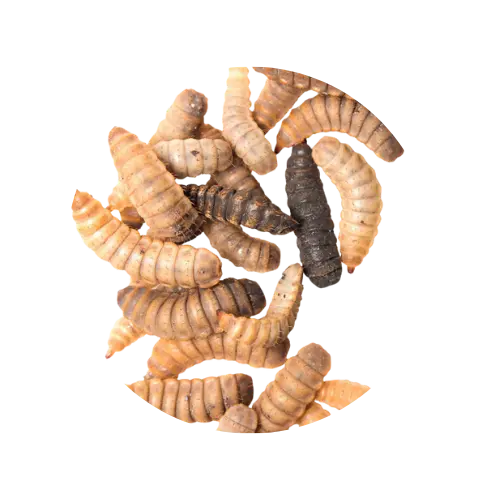
Solider Fly Larvae
Solider Fly Larvae
Promotes bone health and development
Promotes bone, muscular and neurological health
Enables proper calcium absorption

Dubia Roach
Dubia Roach
For muscle
growth and maintenance
For everyday activity and movement
Promotes bone, muscular and neurological health
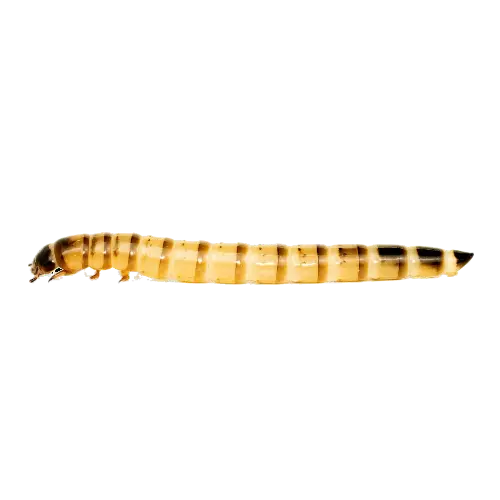
Superworm
Superworm
Promotes bone health and development
Easy to feed and enjoyed by most
Protects nerve and muscle tissue
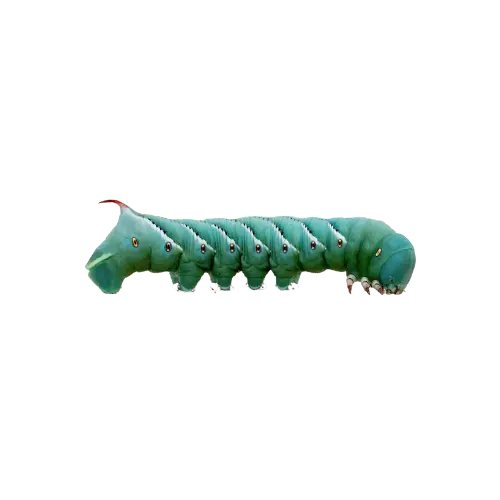
Hornworm
Hornworm
Keeps your pet hydrated
Promotes bone health and development
Easy to eat and digest
Deep dive into insect options (do you have other choices?)
As we stated above, feeding your pet a wide variety of insect options is far more important than the individual insect choices. 1-2 food types is just not sufficient. We recommend using AT LEAST 4 separate insect types. Here are our favorites:
- Dubia Roaches: Dubia Roaches are well regarded among many owners for good reason. They are a solid source of protein, and offer a variety of minerals even when produced with a suboptimal diet. Presumably, proper gut loading and feeding would only improve their micronutrient content.
- Black Soldier Fly Larvae: Commonly called BSFL, Black Soldier Fly Larvae are one of the best feeders around. They are very high in calcium, Magnesium, Potassium, and have higher than average amounts of vitamin D3 and vitamin B12. From a macronutrient perspective, they are well balanced providing both protein and dietary fat.
- Hornworms: High in both water content, and calcium, Hornworms are an excellent addition to ensure your pet doesn’t become dehydrated and gets more calcium.
- Superworms: Superworms have gotten a bad reputation for no reason. They are high in protein, Vitamin E, various amino acids, and overall energy content for your pet. They can contain a higher dietary fat content than other feeder insects. Put simply, there is more energy per gram of superworms, so we just need to feed them less.
Other options (that we don’t like as much):
- Crickets: Crickets are very popular, but only because they are easy to produce. There is nothing special about their nutritional content. They are high in protein, which is great, but are also fairly low in other key nutrients. They present other issues apart from their poor nutritional breakdown: they can jump, are rather stinky, and some owners have observed them biting their pets.
- Mealworms: Mealworms are also very popular, and are very similar nutritionally to superworms. However, superworms are reported as having less phosphorus and seem to in general respond better to proper gut loading.
- Waxworms: Waxworms aren’t a terrible option, they just don’t compare well to other options in nutrient levels.
- Wild caught insects: Although this can be a really great way to increase the diversity of prey items your pet gets, due to the unknown origin we see it as possibly risky. The chance of these insects carrying pesticides or parasites is hard to quantify. Additionally, because we cannot control the diet of insects captured in the wild we’d also have concerns over their true nutritional content. Full disclosure, we sell feeder insects. So there may be a conflict of interest in this point as much as we’ve tried to keep it objective.
Final Point
The actual insect choices that make it to your pets diet are less important than having diversity. No diet is complete with just one insect type and thus most of your focus should be on feeding many diverse feeders rather than obsessing over which feeder insects have what nutrient profiles.
Deep dive into greens options
Greens will primarily offer micronutrients critical to your pet’s health. As many insects don’t contain the calcium, vitamins A, D, E, or omega-3 fatty acids that reptiles need, , we will focus on green options that help fill in these gaps.
Best leafy green options:
- Turnip Greens: 137mg of calcium per 100 grams
- Kale: 53mg of calcium and 50.61mcg of Vitamin A per 21 grams
- Mustard Greens: 64mg of calcium, .045mg of Vitamin B1, and 1.13mg of Vitamin E per 56 grams
- Spring Mix: 50mg of calcium, and a nice mix of various leafy greens to provide various vitamins
Best Vegetable Options (if you decide to include them):
A note on fruit
Given the lack of fruit consumed by wild dragons , we think fruit is best left out of a good captive diet. While certain fruits can provide antioxidants and vitamins, their sugar content likely outweighs this benefit. If you do decide to include fruit in your pet’s diet, keep it very minimal, less than once a month.
Supplements
The use of supplements for reptiles is a much more nuanced topic than most make it out to be. We’ve done our best to present an objective and accurate assessment of supplementation, and whether or not you need to be giving them to your pet.
TLDR:
We do suggest you use a calcium and multivitamin supplement. When used in moderation, the potential for downside is fairly low. If your pet receives a high quality diet, supplements are able to have their intended effect: a secondary ‘insurance policy’ to make sure your pet gets the nutrients they need.
Due to the challenges facing proper and effective supplement use it would be entirely foolish to rely on them as a mainstay of your pet’s nutritional plan.
The challenges with supplements
Many care sources out there preach the benefits of supplements without any regard for the challenges surrounding proper supplementation use. Frankly, it’s not much of a surprise given the widespread commissions offered by supplement sellers. We have no such agreements, and our only objective is to help owners like you do what’s BEST, not what makes us the most money.
Here’s a quick fact: supplements intended for human consumption are not regulated by the FDA the same way drugs and medicine are. Supplement companies are solely responsible for ensuring their products are safe, correctly labeled, and contain what they say they contain.
That’s for human supplements. There is absolutely no regulation we’re aware of for reptile supplements. As a result, the quality of commercial supplements varies dramatically. We are placing our trust completely in the hands of their manufacturers to produce consistent and healthy vitamin and nutrient levels in their products.
Additionally, the way in which we use these untested supplements makes the process even less scientific. Many supplements are dusted onto prey items. This adds additional variables that determine how much of that supplement our pet actually gets. Does it stick appropriately to the insect? How long is it until the insect is consumed (as many insects will groom themselves clean if given the time to do so)?
To make matters worse, we do not have the nutritional science of most reptiles nailed down: we do not know their exact nutrient needs. This adds difficulty to proper use of supplements. Many vitamins and nutrients are either toxic in excess or inhibit the ability of your pet to absorb other required vitamins and nutrients. We need to be careful not to overdo it.
In short, the challenges with supplements are as follows:
- Quality is untested and likely varies by batch and brand
- We are unaware of the individual nutrient needs and limits, making under and over-supplementation possible
- Common techniques such as dusting introduce another set of variables that determine how much of the supplement your pet actually gets
We are aware of various sources who attest that they have raised extremely healthy reptiles (in this case lizards as snakes require no supplementation) with zero supplement usage at all. They did however utilize extremely varied diets that included vertebrate prey.
With this all covered, virtually all veterinarians and researchers agree altering the nutritional content of our pets’ diet, usually via supplements, is a requirement.
What supplements should I use?
As stated above, supplements provided directly to our pets are imprecise at best and introduce a number of challenges. This said, they are critical because feeder insects and some leafy greens are commonly low in the following nutrients:
- Calcium : Use a calcium dust supplement on the insects provided to your pet 2-3 times a week. Some will suggest dusting every feeding. If you’re feeding a diverse diet with high-calcium feeders like the ones outlined above, you’re likely already around a 0.7-1:1 calcium-to-phosphorus ratio. Additionally, many of the leafy greens and vegetables we recommend have calcium-to-phosphorus ratios of 2:1–5:1. It won’t take much supplementation to reach the industry standard recommendation of 2:1 calcium-to-phosphorus. A quick reminder: over-supplementation is certainly possible and can cause a number of issues. As far as product choices, ReptiCalcium by ZooMed is a popular choice.
- Vitamins A and E, thiamin (Vitamin B1), and other nutrient compositions : Use a multivitamin that contains vitamins E and B1, as well as beta carotene (which can be converted to Vitamin A). You’ll find most options contain a wide variety of other minerals, vitamins, and nutrients. Use this once a week at most. If you’re feeding an appropriate diet, 1-2 times a month is better.
A note on gutloading
Here at ReptiBites, we think the future of proper nutrition for reptiles is not in supplement use, but in proper gut loading of insects. Reptiles evolved in habitats that require zero supplementation in their diets. Introducing manufactured, untested, and unregulated supplements to your pet’s diet is clearly suboptimal. As an alternative, gutloading is more natural and likely increases the consistency and controllability of the nutrients added to our pet’s diets.
For these reasons, we follow the latest available research on proper gut-loading for our feeders here. At the time of this writing, we are planning our own testing and experimentation to continue improving the gut-loading process. Our hope is that one day the responsibility for providing the right nutrients to pet reptiles lies with the bug suppliers, and not passed off to owners who don’t have the right tools to do this accurately.
Water
Reptiles are a bit different from other mammal pets in that they source a lot of their hydration from their prey and food. It’s for this reason, we suggest insects like the hornworm that have high water content. This said, offering your pet water in a water dish is a non-negotiable. Providing such access gives your pet the option to drink water when needed. Replace this water bowl with fresh water every couple of days or when soiled.

